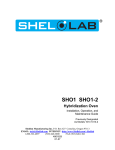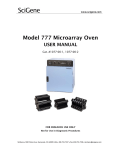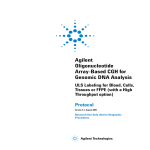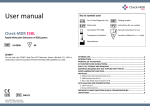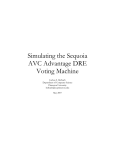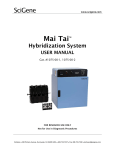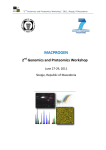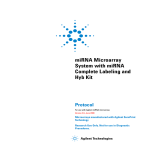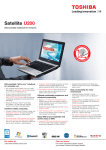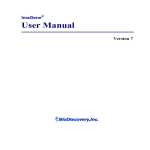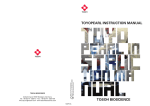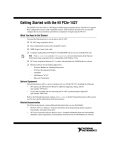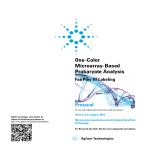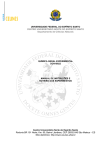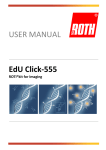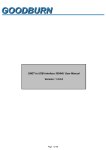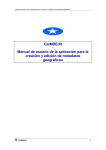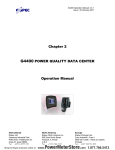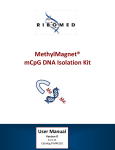Download Agilent Oligonucleotide Array-Based CGH for Genomic DNA
Transcript
Agilent Oligonucleotide Array-Based CGH for Genomic DNA Analysis (for FFPE Samples) Protocol Version 1.0, August 2007 Research Use Only. Not for Diagnostic Procedures. Agilent Technologies Notices © Agilent Technologies, Inc. 2007 Warranty No part of this manual may be reproduced in any form or by any means (including electronic storage and retrieval or translation into a foreign language) without prior agreement and written consent from Agilent Technologies, Inc. as governed by United States and international copyright laws. The material contained in this document is provided “as is,” and is subject to being changed, without notice, in future editions. Further, to the maximum extent permitted by applicable law, Agilent disclaims all warranties, either express or implied, with regard to this manual and any information contained herein, including but not limited to the implied warranties of merchantability and fitness for a particular purpose. Agilent shall not be liable for errors or for incidental or consequential damages in connection with the furnishing, use, or performance of this document or of any information contained herein. Should Agilent and the user have a separate written agreement with warranty terms covering the material in this document that conflict with these terms, the warranty terms in the separate agreement shall control. Manual Part Number G4410-90020 Edition Version 1.0, August 2007 Printed in USA Agilent Technologies, Inc. 5301 Stevens Creek Blvd. Santa Clara, CA 95051 USA Technical Support Technical product support may be obtained by contacting your local Agilent Support Services representative. Agilent’s worldwide sales and support center telephone numbers can be obtained at the following Web site: www.agilent.com/chem/contactus or send an e-mail to: [email protected] If you have comments about this guide, please send an e-mail to [email protected] Notice to Purchaser These products are intended for research use only. Agilent products may not be resold, modified for resale, or used to manufacture commercial products without written approval of Agilent Technologies, Inc. Microsoft ® and Windows® are U.S. registered trademarks of Microsoft Corporation. Technology Licenses The hardware and/or software described in this document are furnished under a license and may be used or copied only in accordance with the terms of such license. Restricted Rights Legend U.S. Government Restricted Rights. Software and technical data rights granted to the federal government include only those rights customarily provided to end user customers. Agilent provides this customary commercial license in Software and technical data pursuant to FAR 12.211 (Technical Data) and 12.212 (Computer Software) and, for the Department of Defense, DFARS 252.227-7015 (Technical Data - Commercial Items) and DFARS 227.7202-3 (Rights in Commercial Computer Software or Computer Software Documentation). Safety Notices CAUTION A CAUTION notice denotes a hazard. It calls attention to an operating procedure, practice, or the like that, if not correctly performed or adhered to, could result in damage to the product or loss of important data. Do not proceed beyond a CAUTION notice until the indicated conditions are fully understood and met. WA R N I N G A WARNING notice denotes a hazard. It calls attention to an operating procedure, practice, or the like that, if not correctly performed or adhered to, could result in personal injury or death. Do not proceed beyond a WARNING notice until the indicated conditions are fully understood and met. Pentium ® is a U.S. registered trademark of Intel Corporation. Array-Based CGH for Genomic DNA Analysis (for FFPE Samples) In This Guide… This guide describes Agilent's recommended operational procedures to analyze DNA copy number variations using Agilent 60-mer oligonucleotide microarrays for array-based comparative genomic hybridization (aCGH) analysis. This protocol is specifically developed and optimized to process DNA samples derived from formalin-fixed paraffin-embedded (FFPE) tissues. 1 Before You Begin This chapter contains information (such as procedural notes, safety information, required reagents and equipment) that you should read and understand before you start an experiment. 2 DNA Isolation This chapter describes the method to isolate genomic DNA (gDNA) from FFPE samples prior to labeling. 3 DNA Labeling This chapter describes the steps to chemically label the gDNA samples with fluorescent dyes through ULS technology. 4 Microarray Processing and Feature Extraction This chapter describes the steps to hybridize, wash and scan Agilent CGH microarrays and to extract data using the Agilent Feature Extraction Software. 5 Reference This chapter contains reference information related to the protocol. Array-Based CGH for Genomic DNA Analysis (for FFPE Samples) 3 4 Array-Based CGH for Genomic DNA Analysis (for FFPE Samples) Contents Contents 1 Before You Begin 7 Procedural Notes 8 Safety Notes 9 Agilent Oligo CGH Microarray Kit Contents Required Equipment 12 Required Reagents 14 Required Hardware and Software 15 2 DNA Isolation 10 17 Step 1. Paraffin Removal 19 Step 2. Proteinase K Treatment 20 Step 3. gDNA Extraction 21 Step 4. gDNA Quantitation and Quality Analysis 23 Supplemental Procedure - To isolate gDNA from frozen tissues 3 4 DNA Labeling 25 27 Step 1. Preparation of gDNA Before Labeling Step 2. Heat Fragmentation 29 Step 3. ULS Labeling 29 Step 4. Free Dye Removal 32 28 Microarray Processing and Feature Extraction 35 Step 1. Preparation of Labeled Genomic DNA for Hybridization 36 Step 2. Microarray Hybridization 41 Step 3. Wash Preparation 43 Step 4. Microarray Washing 46 Step 5. Microarray Scanning using Agilent or GenePix Scanner 51 Step 6. Data Extraction using Feature Extraction Software 53 5 Reference 61 Supporting User Guides 62 Array-Based CGH for Genomic DNA Analysis (for FFPE Samples) 5 Contents Agilent Microarray Layout and Orientation 63 Agilent Information Assets Access Agreement 66 6 Array-Based CGH for Genomic DNA Analysis (for FFPE Samples) Agilent Oligonucleotide Array-Based CGH for Genomic DNA Analysis (for FFPE Samples) Protocol 1 Before You Begin Procedural Notes 8 Safety Notes 9 Agilent Oligo CGH Microarray Kit Contents 10 Required Equipment 12 Required Reagents 14 Required Hardware and Software 15 Make sure you read and understand the information in this chapter and have the necessary equipment and reagents listed before you start an experiment. Agilent Technologies 7 1 Before You Begin Procedural Notes Procedural Notes • Follow the procedure described in this document to isolate gDNA from FFPE samples to increase the likelihood of a successful experiment. • To prevent contamination of reagents by nucleases, always wear powder-free laboratory gloves, and use dedicated solutions and pipettors with nuclease-free aerosol-resistant tips. • Maintain a clean work area. • Do not vortex stock solutions and reactions containing gDNA. Instead, mix gDNA samples by gently tapping the tube with your finger. • Avoid repeated freeze-thaw cycles of stock and diluted gDNA solutions. • When preparing frozen reagent stock solutions for use: 1 Thaw the aliquot as quickly as possible without heating above room temperature. 2 Mix briefly on a vortex mixer, then spin in a microcentrifuge for 5 to 10 seconds to drive the contents off the walls and lid. 3 Store on ice or in a cold block until use. • In general, follow Biosafety Level 1 (BL1) safety rules. 8 Array-Based CGH for Genomic DNA Analysis (for FFPE Samples) Before You Begin Safety Notes 1 Safety Notes CAUTION Wear appropriate personal protective equipment (PPE) when working in the laboratory. WA R N I N G • ULS-Cy3 and ULS-Cy5 are considered hazardous by the OSHA Hazard Communication Standard(29 CFR 1910.1200). Contains material which causes damage to the following organs: kidneys, liver, cardiovascular system, respiratory tract, skin, eye lens or cornea, stomach. May be harmful if swallowed. Avoid contact with eyes, skin and clothing. • Agilent-CGHblock may be harmful if swallowed. Avoid contact with eyes, skin and clothing. • 2X CGH and 2X Hi-RPM Hybridization Buffers are considered hazardous by the OSHA Hazard Communication Standard (29 CFR 1910.1200). Contains material which causes damage to the following organs: skin, central nervous system. May be harmful if swallowed. Avoid contact with eyes, skin and clothing. • Agilent Stabilization and Drying Solution is considered hazardous by the OSHA Hazard Communication Standard (29 CFR 1910.1200). Flammable liquid and vapor. Keep away from heat, sparks and flame. Keep container closed. Use only with adequate ventilation. This solution contains material which causes damage to the following organs: kidneys, liver, cardiovascular system, upper respiratory tract, skin, central nervous system (CNS), eye, lens or cornea. Array-Based CGH for Genomic DNA Analysis (for FFPE Samples) 9 1 Before You Begin Agilent Oligo CGH Microarray Kit Contents Agilent Oligo CGH Microarray Kit Contents Store entire kit at room temperature. After breaking the microarray foil pouch, store the microarray slides at room temperature (in the dark) under a vacuum desiccator or N2 purge box. Do not store microarray slides in open air after breaking foil. Catalog CGH Microarray Kits • Five or ten microarrays printed on five 1-inch × 3-inch glass slides • CD containing microarray design files in various file formats Available designs include: Human Genome CGH Microarray Kit 244A (p/n G4411B) (1x244K) Human Genome CGH Microarray Kit 105A (p/n G4412A) (2x105K) Mouse Genome CGH Microarray Kit 244A (p/n G4415A) (1x244K) Mouse Genome CGH Microarray Kit 105A (p/n G4416A) (2x105K) Rat Genome CGH Microarray Kit 244A (p/n G4435A) (1x244K) Rat Genome CGH Microarray Kit 105A (p/n G4436A) (2x105K) Unrestricted High-Definition CGH (HD-CGH) Microarray Kits • One or four microarray(s) printed on each 1-inch x 3-inch glass slide • Number of microarrays varies per kit and per order • CD containing microarray design files in various file formats Available designs include: Human Genome CGH Microarray 244A-Supplemental (p/n G4423B, AMADID 016266) Human Genome CGH Microarray 4x44K (p/n G4426B, AMADID 014950) Mouse Genome CGH Microarray, 4x44K (p/n G4426B, AMADID 015028) 10 Array-Based CGH for Genomic DNA Analysis (for FFPE Samples) Before You Begin Agilent Oligo CGH Microarray Kit Contents 1 Custom High-Definition CGH (HD-CGH) Microarray Kits • One, two, four or eight microarray(s) printed on each 1-inch × 3-inch glass slide • Number of microarrays varies per kit and per order Available formats include: Custom HD-CGH Microarray, 1x244K (p/n G4423A) Custom HD-CGH Microarray, 2x105K (p/n G4425A) Custom HD-CGH Microarray, 4x44K (p/n G4426A) Custom HD-CGH Microarray, 8x15K (p/n G4427A) Array-Based CGH for Genomic DNA Analysis (for FFPE Samples) 11 1 Before You Begin Required Equipment Required Equipment Description Company and part no. Agilent Microarray Scanner Bundle Agilent p/n G2565BA Hybridization Chamber, stainless Agilent p/n G2534A Hybridization Chamber gasket slides, 5-pack (alternative packaging sizes are available) 1x244K microarrays or 2x105K microarrays or 4x44K microarrays or 8x15K microarrays Agilent p/n G2534-60003 or Agilent p/n G2534-60002 or Agilent p/n G2534-60011 or Agilent p/n G2534-60014 Hybridization oven; temperature set at 65°C Agilent p/n G2545A Hybridization oven rotator for Agilent Microarray Hybridization Chambers Agilent p/n G2530-60029 UV-Transilluminator with SYBR photographic filter Alpha Innotech p/n AlphaImager 2000 or equivalent Nuclease-free 1.5 mL microfuge tubes (sustainable at 95°C) Ambion p/n AM12400 or equivalent 12 Magnetic stir bar (×2 or ×4)* Corning p/n 401435 or equivalent Magnetic stir plate (×1 or ×3)* Corning p/n 6795-410 or equivalent Magnetic stir plate with heating element Corning p/n 6795-420 or equivalent Microcentrifuge Eppendorf p/n 5417R or equivalent PCR machine with heated lid Eppendorf p/n 950000015 or equivalent Nuclease-free 0.2 mL PCR tubes, thin-walled Eppendorf p/n 951010006 or equivalent Thermomixer Eppendorf p/n 022670000 or equivalent E-Gel Opener† Invitrogen p/n G5300-01 E-Gel PowerBase v.4† Invitrogen p/n G6200-04 UV-VIS spectrophotometer NanoDrop p/n ND-1000 or equivalent Array-Based CGH for Genomic DNA Analysis (for FFPE Samples) Before You Begin Required Equipment Description (continued) Company and part no. P10, P20, P200 and P1000 pipettes Pipetman P10, P20, P200, P1000 or equivalent 1.5 L glass dish Pyrex p/n 213-R or equivalent 250 mL capacity slide-staining dish, with slide rack (×3 or ×5)* Wheaton p/n 900200 or equivalent 1 Circulating water baths or heat blocks set to 37°C, 70°, 90° and 95°C Ice bucket Powder-free gloves Speed-vac Sterile, nuclease-free aerosol barrier pipette tips Timer Vacuum dessicator or N2 purge box for slide storage Vortex mixer * The number varies depending on if wash procedure A or B is selected. † Optional when Invitrogen E-gels are used. Array-Based CGH for Genomic DNA Analysis (for FFPE Samples) 13 1 Before You Begin Required Reagents Required Reagents Description Company and part no. Oligo aCGH Labeling Kit for FFPE Samples Agilent p/n 5190-0419 Genomic DNA Purification Module (includes a pack of 10 Agilent KREApure columns) Agilent p/n 5190-0418 Agilent Oligo aCGH Hybridization Kit Agilent p/n 5188-5220 (25) or p/n 5188-5380 (100) Agilent Oligo aCGH Wash Buffer 1 and 2 set or Agilent p/n 5188-5226 Agilent Oligo aCGH Wash Buffer 1 (4 L) Agilent p/n 5188-5221 Agilent Oligo aCGH Wash Buffer 2 (4 L) Agilent p/n 5188-5222 Stabilization and Drying Solution, 500 mL* Agilent p/n 5185-5979 Phosphate Buffered Saline pH 7.4 (PBS) Amresco p/n E504-500ML TrackIt 1 Kb DNA Ladder Invitrogen p/n 10488-072 DNase/RNase-free distilled water Invitrogen p/n 10977-015 Human Cot-1 DNA or Mouse Cot-1 DNA or Rat Hybloc Invitrogen p/n 15279-011 Invitrogen p/n 18440-016 Applied Genetics p/n RHB Clear E-Gel 18-Pak (1.2% agarose, no stain) Invitrogen p/n G5518-01 SYBR Gold Nucleic Acid Gel Stain Invitrogen p/n S11494 For possible use as a reference sample: Human Genomic DNA or Mouse Genomic DNA or Rat Genomic DNA Promega p/n G1521 (female) or p/n G1471 (male) Jackson Labs p/n 000664 (female and male) Harlan Sprague Dawley (custom) Qiagen RNase A (100 mg/mL) Qiagen p/n 19101 Qiagen Proteinase K (>600 mAU/mL, solution) Qiagen p/n 19131 Qiagen DNeasy Blood & Tissue Kit Qiagen p/n 69504 Sodium thiocyanate (NaSCN) Sigma 467871-50G Acetonitrile * Sigma p/n 271004-1L Ethanol (95% to 100% molecular biology grade) Sigma p/n E7023-6x500ML Tween 20 Sigma p/n P9416-50ML * Optional components recommended if wash procedure B is selected. 14 Array-Based CGH for Genomic DNA Analysis (for FFPE Samples) Before You Begin Required Hardware and Software 1 Required Hardware and Software • Pentium III 1.5 GHz or higher (Pentium 4 processor, 2.0 GHz or higher recommended) • 2 GB RAM • 20 GB available disk space (if saving images and result files locally) • Windows 2000 SP2 or later, Windows XP SP2 • PC must be able to load MSDE 2000 release A Version 8.0 • Agilent Feature Extraction software v9.5 • Internet Explorer 5.5 or later • Adobe Acrobat Reader 4.0 or later • Virtual Memory - set at 2 GB To access Virtual Memory settings in Windows XP: 1 Open the Control Panel. 2 Double-click System, and click the Advanced tab. 3 Click Settings (Performance) > Advanced > Change (Virtual Memory). 4 In the Drive list, click the drive that contains the paging file you want to change. 5 Under Paging file size for selected drive, type 2000 into the Initial Size (MB) box and click Set and then OK. To access Virtual Memory settings in Windows 2000: 1 Open the Control Panel. 2 Double-click System, and click the Advanced tab. 3 Click Performance Options > Change (Virtual Memory). 4 In the Drive list, click the drive that contains the paging file you want to change. 5 Under Paging file size for selected drive, type 2000 into the Initial Size (MB) box and click Set and then OK. Array-Based CGH for Genomic DNA Analysis (for FFPE Samples) 15 1 16 Before You Begin Required Hardware and Software Array-Based CGH for Genomic DNA Analysis (for FFPE Samples) Agilent Oligonucleotide Array-Based CGH for Genomic DNA Analysis (for FFPE Samples) Protocol 2 DNA Isolation Step 1. Paraffin Removal 19 Step 2. Proteinase K Treatment 20 Step 3. gDNA Extraction 21 Step 4. gDNA Quantitation and Quality Analysis 23 Supplemental Procedure - To isolate gDNA from frozen tissues 25 NOTE Agilent cannot guarantee microarray performance and does not provide technical support to those who use non-Agilent protocols in processing Agilent microarrays. This chapter describes Agilent’s recommended procedure to isolate genomic DNA (gDNA) from formalin-fixed paraffin-embedded (FFPE) samples and is based on the method described by van Beers et al. (Br J Cancer. 2006 Jan 30; 94(2):333-7). Determine the number of FFPE sections needed for your experiment based on the estimates summarized in Table 1 on page 18. One 20 micron FFPE section containing 1 cm2 of tissue is estimated to generate a minimal yield of 500 ng of gDNA. Agilent’s array-based Comparative Genomic Hybridization (aCGH) application uses a “two-color” process to measure DNA copy number changes in an experimental sample relative to a reference sample. The type of sample used as a reference is a matter of experimental choice; however, many experimenters use normal commercial gDNA as a reference sample. Agilent Technologies 17 2 DNA Isolation Table 1 Estimated number of 20 micron FFPE sections needed per microarray Microarray format gDNA input amount requirement [ng] Estimated number of 20 micron FFPE sections 1x244K microarray 2000 4 to 5 2x105K microarray 1000 3 4x44K microarray 500 2 8x15K microarray 250 1 Oligo aCGH Workflow for FFPE Samples Experimental sample gDNA Reference sample gDNA Heat fragmentation of gDNA Heat fragmentation of gDNA Labeling of gDNA Labeling of gDNA Clean-up of labeled gDNA Clean-up of labeled gDNA Preparation before hybridization 40-hour hybridization (65ºC) Microarray washing Microarray scanning Feature extraction Figure 1 18 Workflow diagram for sample preparation and microarray processing. Array-Based CGH for Genomic DNA Analysis (for FFPE Samples) DNA Isolation Step 1. Paraffin Removal 2 Step 1. Paraffin Removal 1 Equilibrate a heat block or water bath to 90°C and a thermomixer to 37°C. 2 Place up to 5 20-micron FFPE sections into a 1.5 mL nuclease-free microfuge tube. 3 Prepare 10% Tween 20, by adding 100 µL Tween 20 to 900 µL of nuclease-free water. Solution can be prepared in advance and stored up to 6 months at room temperature. 4 Add 480 µL PBS and 20 µL 10% Tween 20 to the FFPE sections in the 1.5 mL nuclease-free microfuge tube. 5 Transfer the sample tube to a circulating water bath or heat block at 90°C. Incubate at 90°C for 10 minutes. 6 Spin immediately for 15 minutes at 10,000 x g in a microcentrifuge. 7 Place the sample tube on ice for 2 minutes. 8 Remove wax disc with a pipette tip or tweezers. Remove and discard the supernatant without disturbing the pellet. 9 Add 1 mL of 100% ethanol to the pellet and vortex briefly. 10 Spin for 5 minutes at 10,000 x g in a microcentrifuge. 11 Remove ethanol without disturbing the pellet and let the sample tube sit at room temperature with the lid open until residual ethanol has completely evaporated. 12 Prepare a 1M NaSCN solution by adding 10 g of NaSCN to 123 mL of nuclease free water. Solution can be prepared in advance and stored up to 1 month at room temperature. 13 Add 400 µL 1M NaSCN to the dry pellet and briefly mix on a vortex mixer. 14 Transfer the sample tube to a thermomixer at 37°C. Incubate overnight at 37°C shaking at 450 rpm. Array-Based CGH for Genomic DNA Analysis (for FFPE Samples) 19 2 DNA Isolation Step 2. Proteinase K Treatment Step 2. Proteinase K Treatment 1 Equilibrate a thermomixer to 55°C. 2 Transfer the sample tube to a microcentrifuge. Spin for 20 minutes at 10,000 x g. 3 Remove and discard the supernatant without disturbing the pellet. 4 Add 400 µL PBS to the pellet and vortex briefly. 5 Spin again for 20 minutes at 10,000 x g in a microcentrifuge. 6 Remove and discard the supernatant without disturbing the pellet. 7 Add 360 µL of Qiagen buffer ATL (supplied with Qiagen DNeasy Blood & Tissue Kit). 8 Add 40 µL proteinase K (supplied with Qiagen DNeasy Blood & Tissue Kit), mix well on a vortex mixer, and incubate overnight in a thermomixer at 55°C shaking at 450 rpm. 9 Transfer the sample tube to a microcentrifuge. Spin for 30 seconds at 6,000 x g to drive the contents off the walls and lid. 10 Add 40 µL proteinase K, mix well on a vortex mixer, and incubate in a thermomixer for approximately 6 to 8 hours at 55°C shaking at 450 rpm. 11 At the end of the day, transfer the sample tube to a microcentrifuge and spin for 30 seconds at 6,000 x g to drive the contents off the walls and lid. 12 Add 40 µL proteinase K, mix well on a vortex mixer, and incubate overnight in a thermomixer at 55°C shaking at 450 rpm. 20 Array-Based CGH for Genomic DNA Analysis (for FFPE Samples) DNA Isolation Step 3. gDNA Extraction 2 Step 3. gDNA Extraction 1 Equilibrate a heat block or water bath to 70°C. 2 Let samples cool to room temperature and spin in a microcentrifuge for 30 seconds at 6,000 x g to drive the contents off the walls and lid. 3 Add 8 µL of RNase A (100 mg/mL), mix on a vortex mixer, and incubate for 2 minutes at room temperature. Transfer the sample tube to a microcentrifuge and spin for 30 seconds at 6,000 x g to drive the contents off the walls and lid. 4 Add 400 µL Buffer AL (supplied with Qiagen DNeasy Blood & Tissue Kit), mix thoroughly on a vortex mixer, and incubate in a circulating water bath or heat block at 70°C for 10 minutes. Transfer the sample tube to a microcentrifuge and spin for 30 seconds at 6,000 x g to drive the contents off the walls and lid. 5 Add 440 µL 100% ethanol, and mix thoroughly on a vortex mixer. Transfer the sample tube to a microcentrifuge and spin for 30 seconds at 6,000 x g to drive the contents off the walls and lid. 6 Place two DNeasy Mini spin columns in two clean 2 mL collection tubes (provided). Split the entire sample mixture onto two DNeasy Mini spin columns (i.e. 660 µL each). NOTE Use 2 DNeasy Mini spin columns per sample to prevent clogging. 7 Spin in a microcentrifuge for 1 minute at 6,000 x g. Discard the flow-through and collection tube. Place the DNeasy Mini spin columns in fresh 2 mL collection tubes (provided). 8 Before using for the first time, prepare Buffer AW1 by adding 100% ethanol to the Buffer AW1 bottle (supplied with Qiagen DNeasy Blood & Tissue Kit; see bottle label for volume). Mark appropriate check box to indicate that ethanol was added to the bottle. 9 Add 500 µL Buffer AW1 onto each spin column, and centrifuge for 1 minute at 6,000 x g. Discard the flow-through and collection tube. Place the DNeasy Mini spin columns in fresh 2 mL collection tubes (provided). Array-Based CGH for Genomic DNA Analysis (for FFPE Samples) 21 2 DNA Isolation Step 3. gDNA Extraction 10 Prepare a fresh 80% ethanol solution by adding 40 mL 100% ethanol to 10 mL nuclease-free water. CAUTION Do not use Buffer AW2 supplied with the Qiagen DNeasy Blood & Tissue Kit for the subsequent step because salt from Buffer AW2 will interfere with the subsequent labeling reaction. 11 Add 500 µL 80% ethanol onto each column, and spin in a microcentrifuge for 3 minutes at 20,000 x g to dry the column membrane. Discard the flow-through and collection tube. 12 Place the DNeasy Mini spin column in a clean 1.5 mL microcentrifuge tube, and add 50 µL of nuclease free water directly to the center of each spin column. 13 Let stand at room temperature for 1 minute, and then spin in a microcentrifuge for 1 minute at 6,000 x g to elute the DNA. 14 Combine the purified DNA from the same sample in one microcentrifuge tube with a final total volume of 100 µL. 22 Array-Based CGH for Genomic DNA Analysis (for FFPE Samples) DNA Isolation Step 4. gDNA Quantitation and Quality Analysis 2 Step 4. gDNA Quantitation and Quality Analysis Accurate assessment of gDNA quantity and quality are crucial to the success of an Agilent Oligo aCGH experiment. High quality gDNA should be free of contaminants such as carbohydrates, proteins, and traces of organic solvents, and should also be intact with minimal degradation. gDNA isolated from FFPE samples typically exhibits varying degrees of degradation depending on the age of the tissue and the paraffin embedding protocol used. Use the NanoDrop ND-1000 UV-VIS Spectrophotometer (or equivalent) to assess gDNA concentration and purity. Use the agarose gel electrophoresis to assess gDNA intactness and the average molecular weight for each sample. This information will be important for the subsequent labeling reaction. 1 Select Nucleic Acid Measurement, then select Sample Type to be DNA-50. 2 Use 1.5 µL of nuclease free water to blank the instrument. 3 Use 1.5 µL of each gDNA sample to measure DNA concentration. Record the gDNA concentration (ng/µL) for each sample. Calculate the yield (µg) by multiplying DNA concentration (ng/µL) by the sample volume (that is, 100 µL) and dividing by 1000. 4 Record the A260/A280 and A260/A230 ratios. High-quality gDNA samples should have an A260/A280 ratio of 1.8 to 2.0, indicating the absence of contaminating proteins, and an A260/A230 ratio of >2.0, indicating the absence of other organic compounds such as guanidinium isothiocyanate, alcohol and phenol as well as cellular contaminants such as carbohydrates. 5 Load 20 ng gDNA for each sample in a volume of 10 µL nuclease-free water in the well of a single-comb 1.2% Clear E-Gel. (No need to add loading buffer in this system). 6 As a control, load 20 ng of commercial Human Genomic DNA in a volume of 10 µL nuclease free water in one of the wells of the E-Gel. 7 Mix 5 µL TrackIt 1 Kb DNA Ladder with 95 µL deionized water and load 10 µL of the diluted ladder in one of the wells of the E-Gel. 8 Run the gel for 30 minutes as described in Invitrogen's instructions. 9 Open the gel cassette with E-Gel Opener as described in Invitrogen’s instructions. Array-Based CGH for Genomic DNA Analysis (for FFPE Samples) 23 2 DNA Isolation Step 4. gDNA Quantitation and Quality Analysis 10 Stain the gel with SYBR Gold Nucleic Acid Gel Stain (diluted 1:10,000 by adding 10 µL of SYBR Gold Nucleic Acid Gel Stain to 100 mL of nuclease-free water) in a plastic tray for 15 minutes. 11 Visualize the gel on the UV-transilluminator using a SYBR Gold photographic filter. 24 Array-Based CGH for Genomic DNA Analysis (for FFPE Samples) DNA Isolation Supplemental Procedure - To isolate gDNA from frozen tissues 2 Supplemental Procedure - To isolate gDNA from frozen tissues This supplemental step describes Agilent’s recommended procedure to isolate genomic DNA (gDNA) from frozen tissue using the Qiagen DNeasy Blood & Tissue Kit (p/n 69504). 1 Equilibrate a thermomixer to 55°C and heat block or water bath to 70°C. 2 Cut up to 25 mg frozen tissue (up to 10 mg for spleen tissue) into small pieces, place into a 1.5 mL microfuge tube, and add 180 µL Buffer ATL. 3 Add 20 µL proteinase K, mix well on a vortex mixer, and incubate in a thermomixer at 55°C shaking at 450 rpm until the tissue is completely lysed. Lysis time varies depending on the type of tissue processed. Usually lysis is complete in 1 to 3 hours. If it is more convenient, samples can be lysed overnight. 4 Let the sample cool to room temperature and spin in a microcentrifuge for 30 seconds at 6,000 x g to drive the contents off the walls and lid. 5 Add 4 µL of RNase A (100 mg/mL), mix on a vortex mixer, and incubate for 2 minutes at room temperature. Spin in a microcentrifuge for 30 seconds at 6,000 x g to drive the contents off the walls and lid. 6 Add 200 µL Buffer AL to each sample, mix thoroughly on a vortex mixer, and incubate at 70°C for 10 minutes in a heat block or water bath. Spin in a microcentrifuge for 30 seconds at 6,000 x g to drive the contents off the walls and lid. 7 Add 200 µL 100% ethanol to each sample, and mix thoroughly on a vortex mixer. Spin in a microcentrifuge for 30 seconds at 6,000 x g to drive the contents off the walls and lid. 8 Transfer the sample mixture onto a DNeasy Mini spin column placed in a 2 mL collection tube (provided). Centrifuge at 6,000 x g for 1 minute. Discard the flow-through and collection tube. Place the DNeasy Mini spin column in a new 2 mL collection tube (provided). 9 Before using for the first time, prepare Buffer AW1 by adding 100% ethanol to the Buffer AW1 bottle (supplied with Qiagen DNeasy Blood & Tissue Kit; see bottle label for volume). Mark the appropriate check box to indicate that ethanol was added to the bottle. Array-Based CGH for Genomic DNA Analysis (for FFPE Samples) 25 2 DNA Isolation Supplemental Procedure - To isolate gDNA from frozen tissues 10 Add 500 µL Buffer AW1 onto the column, and spin in a microcentrifuge for 1 minute at 6,000 x g. Discard the flow-through and collection tube. Place the DNeasy Mini spin column in a new 2 mL collection tube (provided). 11 Prepare a fresh 80% ethanol solution by adding 40 mL 100% ethanol to 10 mL nuclease-free water. CAUTION Do not use Buffer AW2 supplied with the Qiagen DNeasy Blood & Tissue Kit for the subsequent step because salt from Buffer AW2 will interfere with the subsequent labeling reaction. 12 Add 500 µL 80% ethanol onto the column, and centrifuge for 3 minutes at 20,000 x g to dry the DNeasy membrane. Discard the flow-through and collection tube. 13 Place the DNeasy Mini spin column in a clean 1.5 mL microcentrifuge tube, and pipet 200 µL of nuclease free water directly onto the center of the DNeasy column membrane. 14 Incubate at room temperature for 1 minute, and then spin in a microcentrifuge for 1 minute at 6,000 x g to elute the DNA. 15 Repeat elution with nuclease free water once as described in step 13 and step 14. Combine the duplicate samples in one microcentrifuge tube for a final volume of 400 µL. 16 Measure gDNA concentration and purity, and analyze on an agarose gel as described in “Step 4. gDNA Quantitation and Quality Analysis” on page 23. 26 Array-Based CGH for Genomic DNA Analysis (for FFPE Samples) Agilent Oligonucleotide Array-Based CGH for Genomic DNA Analysis (for FFPE Samples) Protocol 3 DNA Labeling Step 1. Preparation of gDNA Before Labeling 28 Step 2. Heat Fragmentation 29 Step 3. ULS Labeling 29 Step 4. Free Dye Removal 32 The Agilent Oligo aCGH Labeling Kit for FFPE Samples offers a one-step non-enzymatic procedure to differentially label gDNA samples with fluorescent dyes. For Agilent's Oligo aCGH application, the experimental sample is labeled with one dye while the reference sample is labeled with the other dye. The “polarity” of the sample labeling is a matter of experimental choice. Equal amounts of gDNA for both the experimental and reference channels should be used. The required gDNA input amount depends on the microarray format used (see Table 2 on page 28). CAUTION gDNA samples need to be clean of salt and other (wash) buffer components as well as divalent cations (e.g. Mg 2+) which can disturb the subsequent labeling efficiency. Follow the DNA isolation procedure described in Chapter 2, “DNA Isolation”. Failure to do so will result in unsatisfactory microarray results. Agilent Technologies 27 3 DNA Labeling Step 1. Preparation of gDNA Before Labeling Table 2 Requirement of gDNA Input Amount and Volume per Microarray Microarray format gDNA input amount [ng] Volume of gDNA [µL] Minimum gDNA concentration [ng/µL] 1x244K microarray 2000 16 125 2x105K microarray 1000 17 59 4x44K microarray 500 8 62.5 8x15K microarray 250 8 32 Step 1. Preparation of gDNA Before Labeling 1 If the gDNA concentration is less than 125 ng/µL (for 1x244K microarrays), 59 ng/µL (for 2x105K microarrays), 62.5 ng/µL (for 4x44K microarrays), or 32 ng/µL (for 8x15K microarrays), concentrate the sample using a speed-vac before you proceed to the heat fragmentation. 2 Add 2 µg of gDNA and the appropriate volume of nuclease-free water to bring to a final volume of 16 µL (for 1x244K microarrays), 1 µg of gDNA and the appropriate volume of nuclease-free water to bring to a final volume of 17 µL (for 2x105K microarrays), 500 ng of gDNA and the appropriate volume of nuclease-free water to bring to a final volume of 8 µL (for 4x44K microarrays), or 250 ng of gDNA and the appropriate volume of nuclease-free water to bring to a final volume of 8 µL (for 8x15K microarrays) in a 0.2 mL nuclease-free PCR tube. 28 Array-Based CGH for Genomic DNA Analysis (for FFPE Samples) DNA Labeling Step 2. Heat Fragmentation 3 Step 2. Heat Fragmentation 1 Estimate the average molecular weight for each gDNA sample based on the agarose gel analysis (see “DNA Isolation” on page 17). 2 Fragment the gDNA samples by incubating at 95°C in a PCR machine with heated lid for the time period indicated in Table 3. 3 Transfer the sample tubes to ice and incubate on ice for 3 minutes. 4 Spin in a microcentrifuge for 30 seconds at 6,000 × g to drive the contents off the walls and lid. Table 3 Length of heat fragmentation Average molecular weight Sample type Fragmentation time > 10 KB Reference sample with intact gDNA 10 minutes > 7 KB Some fresh FFPE samples 5 minutes < 7 KB Most FFPE samples No fragmentation Step 3. ULS Labeling NOTE ULS-Cy3 and ULS-Cy5 are light sensitive. Minimize light exposure throughout the labeling procedure. 1 Prepare the Labeling Master Mix by mixing the components in Table 4, Table 5, Table 6, or Table 7 on ice based on the microarray format of choice. Avoid pipetting volumes less than 2 µL to ensure accuracy. Table 4 Preparation of Labeling Master Mix (for 1x244K microarray) Components Per reaction (µL) Per slide (µL) ULS-Cy3 or ULS-Cy5 2 2 10 x labeling solution 2 2 Final volume of Labeling Master Mix 4 4 Array-Based CGH for Genomic DNA Analysis (for FFPE Samples) 29 3 DNA Labeling Step 3. ULS Labeling Table 5 Components Per reaction (µL) Per slide (µL) (including excess) ULS-Cy3 or ULS-Cy5 1 2.5 10 x labeling solution 2 5 Final volume of Labeling Master Mix 3 7.5 Table 6 Preparation of Labeling Master Mix (for 4x44K microarray) Components Per reaction (µL) Per slide (µL) (including excess) Nuclease-free water 0.5 2.5 ULS-Cy3 or ULS-Cy5 0.5 2.5 10 x labeling solution 1 5 Final volume of Labeling Master Mix 2 10 Table 7 30 Preparation of Labeling Master Mix (for 2x105K microarray) Preparation of Labeling Master Mix (for 8x15K microarray) Components Per reaction (µL) Per slide (µL) (including excess) Nuclease-free water 0.75 7.5 ULS-Cy3 or ULS-Cy5 0.25 2.5 10 x labeling solution 1 10 Final volume of Labeling Master Mix 2 20 Array-Based CGH for Genomic DNA Analysis (for FFPE Samples) DNA Labeling Step 3. ULS Labeling 3 2 Add the appropriate amount of Labeling Master Mix to each PCR tube containing the gDNA to make a total volume as listed in Table 8. Mix well by gently pipetting up and down. Table 8 Amount of Labeling Master Mix to add Microarray format Volume of Labeling Master Mix Volume of gDNA Total volume 1x244K microarray 4 µL 16 µL 20 µL 2x105K microarray 3 µL 17 µL 20 µL 4x44K microarray 2 µL 8 µL 10 µL 8x15K microarray 2 µL 8 µL 10 µL 3 Transfer PCR tubes to a PCR machine with heated lid and incubate at 85°C for 30 minutes. 4 Transfer the samples to ice and incubate on ice for 3 minutes. 5 Spin in a microcentrifuge for 1 minute at 6,000 × g to drive the contents off the walls and lid. Labeled gDNA can be stored on ice until dye removal using the Agilent KREApure columns. 6 For 4x44K microarrays samples only: add 10 µL of nuclease free water to each PCR tube to make a total volume of 20 µL. CAUTION Do not add nuclease free water to the 8x15K microarray sample tubes as dilution of the samples will prevent accurate measurement of gDNA concentration and Degree of Labeling by Nanodrop. Array-Based CGH for Genomic DNA Analysis (for FFPE Samples) 31 3 DNA Labeling Step 4. Free Dye Removal Step 4. Free Dye Removal Free ULS-Cy3 or ULS-Cy5 can interfere with the subsequent microarray experiment and increase background noise if they are not efficiently removed prior to hybridization. Agilent KREApure columns are provided to effectively remove free ULS dye. NOTE Use the same microcentrifuge and centrifuge speed and length for all three spinning steps (step 4, step 7 and step 11). 1 Resuspend Agilent KREApure column material by briefly mixing on a vortex mixer. 2 Loosen cap ¼ turn and snap off the bottom closure. 3 Place the Agilent KREApure column in a 2 mL collection tube. 4 Pre-spin the Agilent KREApure column in a microcentrifuge for 1 minute at maximum speed (minimum 16,000 x g). 5 Discard the flow-through and place the Agilent KREApure column back to the same collection tube. 6 Add 300 µL nuclease free water to the Agilent KREApure column. 7 Spin again in a microcentrifuge for 1 minute at maximum speed (minimum 16,000 x g). 8 Discard the flow-through and collection tube. 9 Transfer Agilent KREApure column to a clean 1.5 mL heat-resistant microcentrifuge tube. 10 Add ULS-labeled gDNA (20 µL or 10 µL for 8x15K microarray samples) onto Agilent KREApure column. 11 Spin in a microcentrifuge for 1 minute at maximum speed (minimum 16,000 x g) to collect the purified labeled gDNA in the collection tube. 12 Use the NanoDrop ND-1000 UV-VIS Spectrophotometer to measure the Degree of Labeling: a Select MicroArray Measurement, then select Sample Type to be DNA-50. b Blank the instrument with 1.5 µL of 1x labeling solution. c Use 1.5 µL of each labeled gDNA sample for quantitation. Measure the absorbance at A260 nm (DNA), A550 nm (Cy3), and A650 nm (Cy5). 32 Array-Based CGH for Genomic DNA Analysis (for FFPE Samples) DNA Labeling Step 4. Free Dye Removal 3 d Calculate the Degree of Labeling of the labeled gDNA: 340 × pmol per μL dye Degree of Labeling = ------------------------------------------------------------------------------- × 100% ng per μL genomic DNA × 1000 As a general guideline, an optimal Degree of Labeling lies between 1.5% and 2.5%. 13 Combine the appropriate ULS-Cy5-labeled sample and ULS-Cy3-labeled sample for a total volume of 37 µL (for 1x244K, 2x105K and 4x44K microarrays) or 17 µL (for 8x15K microarrays) in a 1.5-mL heat-resistant microfuge tube. Labeled gDNA can be stored overnight at -20°C in the dark. Array-Based CGH for Genomic DNA Analysis (for FFPE Samples) 33 3 34 DNA Labeling Step 4. Free Dye Removal Array-Based CGH for Genomic DNA Analysis (for FFPE Samples) Agilent Oligonucleotide Array-Based CGH for Genomic DNA Analysis (for FFPE Samples) Protocol 4 Microarray Processing and Feature Extraction Step 1. Preparation of Labeled Genomic DNA for Hybridization 36 Step 2. Microarray Hybridization 41 Step 3. Wash Preparation 43 Step 4. Microarray Washing 46 Step 5. Microarray Scanning using Agilent or GenePix Scanner 51 Step 6. Data Extraction using Feature Extraction Software 53 Microarray processing consists of hybridization, washing, and scanning. Feature Extraction is the process by which data is extracted from the scanned microarray image (.tif), allowing researchers to measure DNA copy number changes in their experiments in conjunction with Agilent CGH Analytics Software. Agilent Technologies 35 4 Microarray Processing and Feature Extraction Step 1. Preparation of Labeled Genomic DNA for Hybridization Step 1. Preparation of Labeled Genomic DNA for Hybridization 1 Prepare the 10X CGH Blocking Agent: a Add 1350 µL of nuclease-free water to the vial containing lyophilized 10X CGH Blocking Agent (supplied with Agilent Oligo aCGH Hybridization Kit). b Mix briefly on a vortex mixer and leave at room temperature for 60 minutes to reconstitute sample before use or storage. c 2 Equilibrate water baths or heat blocks to 95°C and 37°C. 3 Use a speed-vac to concentrate the combined Cy5- and Cy3-labeled gDNA mixture to the final volume listed below according to the microarray format: 36 1x244K microarray 28 µL 2x105K microarray 14 µL 4x44K microarray 12 µL 8x15K microarray 5 µL Array-Based CGH for Genomic DNA Analysis (for FFPE Samples) Microarray Processing and Feature Extraction Step 1. Preparation of Labeled Genomic DNA for Hybridization 4 4 Prepare the Hybridization Master Mix by mixing the components in the table below according to the microarray format: Table 9 Preparation of Hybridization Master Mix for 1x244K microarray Component Volume per hybridization Volume per slide 50 µL 50 µL 52 µL 52 µL Agilent 2X CGH Hybridization Buffer† 260 µL 260 µL Final volume of Hybridization Master Mix 362 µL 362 µL Cot-1 DNA (1.0 mg/mL)* Agilent 10X CGH Blocking Agent † * Use Cot-1 DNA from the appropriate species. † Supplied with Agilent Oligo aCGH Hybridization Kit Table 10 Preparation of Hybridization Master Mix for 2x105K microarray Component Volume per hybridization Volume per slide (including excess) Cot-1 DNA (1.0 mg/mL)* 25 µL 62.5 µL Agilent 10X CGH Blocking Agent† 26 µL 65 µL Agilent 2X CGH Hybridization Buffer† 130 µL 325 µL Final volume of Hybridization Master Mix 181 µL 452.5 µL * Use Cot-1 DNA from the appropriate species. † Supplied with Agilent Oligo aCGH Hybridization Kit Array-Based CGH for Genomic DNA Analysis (for FFPE Samples) 37 4 Microarray Processing and Feature Extraction Step 1. Preparation of Labeled Genomic DNA for Hybridization Table 11 Preparation of Hybridization Master Mix for 4x44K microarray Component Volume per hybridization Volume per slide (including excess) Cot-1 DNA (1.0 mg/mL)* 5 µL 25 µL Agilent 10X CGH Blocking Agent† 11 µL 55 µL Agilent 2X CGH Hybridization Buffer† 55 µL 275 µL Final volume of Hybridization Master Mix 71 µL 355 µL * Use Cot-1 DNA from the appropriate species. † Supplied with Agilent Oligo aCGH Hybridization Kit Table 12 Preparation of Hybridization Master Mix for 8x15K microarray Component Volume per hybridization Volume per slide (including excess) Cot-1 DNA (1.0 mg/mL)* 2 µL 20 µL Agilent 10X CGH Blocking Agent† 4.5 µL 45 µL Agilent 2X CGH Hybridization Buffer† 22.5 µL 225 µL Final volume of Hybridization Master Mix 29 µL 290 µL * Use Cot-1 DNA from the appropriate species. † Supplied with Agilent Oligo aCGH Hybridization Kit 38 Array-Based CGH for Genomic DNA Analysis (for FFPE Samples) Microarray Processing and Feature Extraction Step 1. Preparation of Labeled Genomic DNA for Hybridization 4 5 Add the appropriate volume of the Hybridization Master Mix to each 1.5 mL microfuge tube containing the labeled gDNA to make the total volume listed in Table 13. Table 13 Volume of Hybridization Master Mix per hybridization Microarray format Volume of Hybridization Master Mix Total volume 1x244K microarray 362 µL 390 µL 2x105K microarray 181 µL 195 µL 4x44K microarray 71 µL 83 µL 8x15K microarray 29 µL 34 µL 6 Mix the sample by pipetting up and down, and then quickly spin in a microcentrifuge to drive the contents off the walls and lid. 7 Transfer sample tubes to a circulating water bath or heat block at 95°C. Incubate at 95°C for 3 minutes. 8 Immediately transfer sample tubes to a circulating water bath or heat block at 37°C. Incubate at 37°C for 30 minutes. 9 Remove sample tubes from the water bath or heat block. Quickly spin in a microcentrifuge to drive the contents off the walls and lid. 10 Add the appropriate volume of Agilent-CGHblock (supplied with the Agilent Oligo aCGH Labeling Kit for FFPE Samples) to each 1.5 mL microfuge tube containing the labeled gDNA and Hybridization Master Mix to make the final volume of hybridization sample mixture listed in Table 14. Mix well by pipetting up and down. Array-Based CGH for Genomic DNA Analysis (for FFPE Samples) 39 4 Microarray Processing and Feature Extraction Step 1. Preparation of Labeled Genomic DNA for Hybridization Table 14 Volume of Agilent-CGHblock per hybridization Microarray format Volume of Agilent-CGHblock Final volume of hybridization sample mixture 1x244K microarray 130 µL 520 µL 2x105K microarray 65 µL 260 µL 4x44K microarray 27 µL 110 µL 8x15K microarray 11 µL 45 µL 11 Spin 1 minute at 17,900 × g in a microcentrifuge to collect the sample at the bottom of the reaction tube. 40 Array-Based CGH for Genomic DNA Analysis (for FFPE Samples) Microarray Processing and Feature Extraction Step 2. Microarray Hybridization 4 Step 2. Microarray Hybridization NOTE Familiarize yourself with the assembly and disassembly instructions for use with the Agilent Microarray Hybridization Chamber and gasket slides. Please refer to the Agilent Microarray Hybridization Chamber User Guide (G2534-90001) for in-depth instructions on how to load samples, assemble and disassemble chambers, as well as other helpful tips. This user guide is available with the purchase of Agilent Microarray Hybridization Chamber Kit (G2534A) and can also be downloaded from the Agilent Web site at www.agilent.com/chem/dnamanuals-protocols. Practice slide kits are also available. Microarray Handling Tips Each microarray is printed on the side of the glass slide containing the “Agilent”-labeled barcode. This side is called the “active side”. The numeric barcode is on the “inactive side” of the glass slide. The hybridization sample mixture is applied directly to the gasket slide and not to the active side of the microarray slide. Then the active side of the microarray slide is placed on top of the gasket slide to form a “sandwich slide pair”. To avoid damaging the microarray, always handle glass slides carefully by their edges. Wear powder-free gloves. Never touch the surfaces of the slides. If you do, you may cause irreparable damage to the microarray. Never allow the microarray surface to dry out during the hybridization process and washing steps. Hybridization Assembly 1 Load a clean gasket slide into the Agilent SureHyb chamber base with the gasket label facing up and aligned with the rectangular section of the chamber base. Ensure that the gasket slide is flush with the chamber base and is not ajar. 2 Slowly dispense 490 µL (for 1x244K microarray), 245 µL (for 2x105K microarray), 100 µL (for 4x44K microarray) or 40 µL (for 8x15K microarray) of hybridization sample mixture onto the gasket well in a “drag and dispense” manner. For multi-pack microarray formats (i.e. 2x105K, 4x44K or 8x15K microarray), load all gasket wells before placing the microarray slide. Array-Based CGH for Genomic DNA Analysis (for FFPE Samples) 41 4 Microarray Processing and Feature Extraction Step 2. Microarray Hybridization 3 Place a microarray slide “active side” down onto the gasket slide, so the numeric barcode side is facing up and the “Agilent”-labeled barcode is facing down. Assess that the sandwich-pair is properly aligned. 4 Place the SureHyb chamber cover onto the sandwiched slides and slide the clamp assembly onto both pieces. 5 Hand-tighten the clamp onto the chamber. 6 Vertically rotate the assembled chamber to wet the slides and assess the mobility of the bubbles. Tap the assembly on a hard surface if necessary to move stationary bubbles. 7 Place assembled slide chamber in the rotator rack in a hybridization oven set to 65°C. Set your hybridization rotator to rotate at 20 rpm. 8 Hybridize at 65°C for 40 hours. CAUTION If you are not loading all the available positions on the hybridization rotator rack, be sure to balance the loaded hybridization chambers on the rack similar to a centrifuge to prevent unnecessary strain on the oven motor. For more information on the effects of hybridization temperature and time, as well as the rotation speed on the final microarray results, please refer to the application note titled “60-mer Oligo-Based Comparative Genomic Hybridization” (publication 5989-4848EN) from the Agilent Web site at www.agilent.com/chem/dnaapplications. 42 Array-Based CGH for Genomic DNA Analysis (for FFPE Samples) Microarray Processing and Feature Extraction Step 3. Wash Preparation 4 Step 3. Wash Preparation NOTE Cyanine 5 has been shown to be sensitive to ozone degradation. Ozone levels as low as 5 ppb (approximately 10 µg/m3) can affect Cyanine 5 signal and compromise microarray results. The Agilent Stabilization and Drying Solution is designed to protect against ozone-induced degradation of Cyanine dyes. Use this solution when working with Agilent oligo-based microarrays in high ozone environments. Before you begin, determine which wash procedure to use: • Use “Wash Procedure A (without Stabilization and Drying Solution)” on page 46 if you are washing slides in an ozone-controlled environment, and the ozone level is 5 ppb or less. • Use “Wash Procedure B (with Stabilization and Drying Solution)” on page 48 if you are washing slides in an environment in which the ozone level exceeds 5 ppb. Equipment Preparation CAUTION Do not use detergent to wash the staining dishes as some detergents may leave fluorescent residue on the dishes. If you do, you must ensure that all traces are removed by thoroughly rinsing with Milli-Q water. • Always use clean equipment when conducting the wash procedures. • Use only dishes that are designated and dedicated for use in Agilent oligo aCGH experiments. • Cleaning with Milli-Q Water Wash Rinse slide-staining dishes, slide racks and stir bars thoroughly with high-quality Milli-Q water before use and in between washing groups. a Run copious amounts of Milli-Q water through the slide-staining dishes, slide racks and stir bars. b Empty out the water collected in the dishes at least five times. c Repeat step a and step b until all traces of contaminating material are removed. • Cleaning with Acetonitrile Wash (Wash Procedure B Only) Array-Based CGH for Genomic DNA Analysis (for FFPE Samples) 43 4 Microarray Processing and Feature Extraction Step 3. Wash Preparation Acetonitrile wash removes any remaining residue of Agilent Stabilization and Drying Solution from slide-staining dishes, slide racks and stir bars that were used in previous experiments with “Wash Procedure B (with Stabilization and Drying Solution)” on page 48. WA R N I N G Do acetonitrile washes in a vented fume hood. Acetonitrile is highly flammable and toxic. a Add the slide rack and stir bar to the slide-staining dish, and transfer to a magnetic stir plate. b Fill the slide-staining dish with 100% acetonitrile. c Turn on the magnetic stir plate and adjust the speed to a setting of 4 (medium speed). d Wash for 5 minutes at room temperature. e Discard the acetonitrile as is appropriate for your site. f Repeat step a through step e. g Air dry everything in the vented fume hood. h Continue with the Milli-Q water wash as previously instructed. Prewarming Oligo aCGH Wash Buffer 2 (Overnight) The temperature of Oligo aCGH Wash Buffer 2 must be at 37°C for optimal performance. 1 Add the volume of buffer required to a disposable plastic bottle and warm overnight in an incubator or circulating water bath set to 37°C. 2 Put a slide-staining dish into a 1.5 L glass dish three-fourths filled with water and warm to 37°C by storing overnight in an incubator set to 37°C. Prewarming Stabilization and Drying Solution (Wash Procedure B Only) The Agilent Stabilization and Drying Solution contains an ozone scavenging compound dissolved in acetonitrile. The compound in solution is present in saturating amounts and may precipitate from the solution under normal storage conditions. If the solution shows visible precipitation, warming of the solution will be necessary to redissolve the compound. Washing slides using Stabilization and Drying Solution showing visible precipitation will have profound adverse affects on array performance. 44 Array-Based CGH for Genomic DNA Analysis (for FFPE Samples) Microarray Processing and Feature Extraction Step 3. Wash Preparation 4 WA R N I N G The Agilent Stabilization and Drying Solution is a flammable liquid. Warming the solution will increase the generation of ignitable vapors. Use gloves and eye/face protection in every step of the warming procedures. WA R N I N G Do not use an open flame or a microwave. Do not increase temperature rapidly. Warm and mix the material away from ignition sources. WA R N I N G Failure to follow the outlined process will increase the potential for fire, explosion, and possible personal injury. 1 Warm the solution slowly in a water bath set to 37°C to 40°C in a closed container with sufficient head space to allow for expansion. Warm the solution only in a controlled and contained area that meets local fire code requirements. The original container can be used to warm the solution. Container volume is 700 mL and contains 500 mL of liquid. If a different closed container is used, maintain or exceed this headspace/liquid ratio. The time needed to completely redissolve the precipitate is dependent on the amount of precipitate present, and may require overnight warming if precipitation is heavy. 2 Gently shake the container to obtain a homogenous solution. 3 After the precipitate is completely dissolved, allow the solution to equilibrate to room temperature prior to use. CAUTION Do not filter the Stabilization and Drying solution, or the concentration of the ozone scavenger may vary. Array-Based CGH for Genomic DNA Analysis (for FFPE Samples) 45 4 Microarray Processing and Feature Extraction Step 4. Microarray Washing Step 4. Microarray Washing • Use “Wash Procedure A (without Stabilization and Drying Solution)” on page 46 if you are washing microarray slides in an ozone-controlled environment, and the ozone level is 5 ppb or less. • Use “Wash Procedure B (with Stabilization and Drying Solution)” on page 48 if you are washing microarray slides in an environment in which the ozone level exceeds 5 ppb. Wash Procedure A (without Stabilization and Drying Solution) Always use fresh Oligo aCGH Wash Buffer 1 and Oligo aCGH Wash Buffer 2 for each wash group (up to five slides). Table 15 lists the wash conditions for the Wash Procedure A without Stabilization and Drying Solution. Table 15 Wash conditions Dish Wash buffer Temperature Time Disassembly #1 Oligo aCGH Wash Buffer 1 Room temperature 1st wash #2 Oligo aCGH Wash Buffer 1 Room temperature 5 minutes 2nd wash #3 Oligo aCGH Wash Buffer 2 37°C 1 minute 1 Completely fill slide-staining dish #1 with Oligo aCGH Wash Buffer 1 at room temperature. 2 Place a slide rack into slide-staining dish #2. Add a magnetic stir bar. Fill slide-staining dish #2 with enough Oligo aCGH Wash Buffer 1 at room temperature to cover the slide rack. Place this dish on a magnetic stir plate. 3 Put the prewarmed 1.5 L glass dish filled with water and containing slide-staining dish #3 on a magnetic stir plate with heating element. Fill the slide-staining dish #3 approximately three-fourths full with Oligo aCGH Wash Buffer 2 (warmed to 37°C). Add a magnetic stir bar. Turn on the heating element and maintain temperature of Oligo aCGH Wash Buffer 2 at 37°C; monitor using a thermometer. 46 Array-Based CGH for Genomic DNA Analysis (for FFPE Samples) Microarray Processing and Feature Extraction Step 4. Microarray Washing 4 4 Remove one hybridization chamber from incubator and record time. Record whether bubbles formed during hybridization and if all bubbles are rotating freely. 5 Prepare the hybridization chamber disassembly. a Place the hybridization chamber assembly on a flat surface and loosen the thumbscrew, turning counter-clockwise. b Slide off the clamp assembly and remove the chamber cover. c With gloved fingers, remove the array-gasket sandwich from the chamber base by grabbing the slides from their ends. Keep the microarray slide numeric barcode facing up as you quickly transfer the sandwich to slide-staining dish #1. d Without letting go of the slides, submerge the array-gasket sandwich into slide-staining dish #1 containing Oligo aCGH Wash Buffer 1. 6 With the sandwich completely submerged in Oligo aCGH Wash Buffer 1, pry the sandwich open from the barcode end only. Do this by slipping one of the blunt ends of the forceps between the slides and then gently turn the forceps upwards or downwards to separate the slides. Let the gasket slide drop to the bottom of the staining dish. Remove the microarray slide and place into slide rack in the slide-staining dish #2 containing Oligo aCGH Wash Buffer 1 at room temperature. Minimize exposure of the slide to air. Touch only the barcode portion of the microarray slide or its edges! 7 Repeat step 4 through step 6 for up to four additional slides in the group. A maximum of five disassembly procedures yielding five microarray slides is advised at one time in order to facilitate uniform washing. 8 When all slides in the group are placed into the slide rack in slide-staining dish #2, stir using setting 4 for 5 minutes. Adjust the setting to get good but not vigorous mixing. 9 Transfer slide rack to slide-staining dish #3 containing Oligo aCGH Wash Buffer 2 at 37°C, and stir using setting 4 for 1 minute. 10 Slowly remove the slide rack trying to minimize droplets on the slides. It should take 5 to 10 seconds to remove the slide rack. 11 Discard used Oligo aCGH Wash Buffer 1 and Oligo aCGH Wash Buffer 2. 12 Repeat step 1 through step 11 for the next group of five slides using fresh Oligo aCGH Wash Buffer 1 and Oligo aCGH Wash Buffer 2 pre-warmed to 37°C. Array-Based CGH for Genomic DNA Analysis (for FFPE Samples) 47 4 Microarray Processing and Feature Extraction Step 4. Microarray Washing 13 Scan slides immediately to minimize impact of environmental oxidants on signal intensities. If necessary, store slides in the original slide boxes in a N2 purge box, in the dark. Wash Procedure B (with Stabilization and Drying Solution) Cy5 is susceptible to degradation by ozone. Use this wash procedure if the ozone level exceeds 5 ppb in your laboratory. Always use fresh Oligo aCGH Wash Buffer 1 and Oligo aCGH Wash Buffer 2 for each wash group (up to five slides). The acetonitrile (dish #4) and Stabilization and Drying Solution (dish #5) below may be reused for washing up to 4 batches of 5 slides (total 20 slides). WA R N I N G The Stabilization and Drying Solution must be set-up in a fume hood. Place the Wash Buffer 1 and Wash Buffer 2 set-up areas close to, or preferably in, the same fume hood. Use gloves and eye/face protection in every step of the washing procedure. Table 16 lists the wash conditions for the Wash Procedure B with Stabilization and Drying Solution. Table 16 Wash conditions Dish Wash Buffer Temperature Time Disassembly #1 Oligo aCGH Wash Buffer 1 Room temperature 1st wash #2 Oligo aCGH Wash Buffer 1 Room temperature 5 minutes 2nd wash #3 Oligo aCGH Wash Buffer 2 37°C 1 minute Acetonitrile wash #4 Acetonitrile Room temperature 1 minute 3rd wash #5 Stabilization and Drying Solution Room temperature 30 seconds 1 Completely fill slide-staining dish #1 with Oligo aCGH Wash Buffer 1 at room temperature. 48 Array-Based CGH for Genomic DNA Analysis (for FFPE Samples) Microarray Processing and Feature Extraction Step 4. Microarray Washing 4 2 Place a slide rack into slide-staining dish #2. Add a magnetic stir bar. Fill slide-staining dish #2 with enough Oligo aCGH Wash Buffer 1 at room temperature to cover the slide rack. Place this dish on a magnetic stir plate. 3 Put the prewarmed 1.5 L glass dish filled with water and containing slide-staining dish #3 on a magnetic stir plate with heating element. Fill the slide-staining dish #3 approximately three-fourths full with Oligo aCGH Wash Buffer 2 (warmed to 37°C). Add a magnetic stir bar. Turn on the heating element and maintain temperature of Oligo aCGH Wash Buffer 2 at 37°C; monitor using a thermometer. 4 In the fume hood, fill slide-staining dish #4 approximately three-fourths full with acetonitrile. Add a magnetic stir bar and place this dish on a magnetic stir plate. 5 In the fume hood, fill slide-staining dish #5 approximately three-fourths full with Stabilization and Drying Solution. Add a magnetic stir bar and place this dish on a magnetic stir plate. 6 Remove one hybridization chamber from incubator and record time. Record whether bubbles formed during hybridization, and if all bubbles are rotating freely. 7 Prepare the hybridization chamber disassembly. a Place the hybridization chamber assembly on a flat surface and loosen the thumbscrew, turning counter-clockwise. b Slide off the clamp assembly and remove the chamber cover. c With gloved fingers, remove the array-gasket sandwich from the chamber base by grabbing the slides from their ends. Keep the microarray slide numeric barcode facing up as you quickly transfer the sandwich to slide-staining dish #1. d Without letting go of the slides, submerge the array-gasket sandwich into slide-staining dish #1 containing Oligo aCGH Wash Buffer 1. 8 With the sandwich completely submerged in Oligo aCGH Wash Buffer 1, pry the sandwich open from the barcode end only. Do this by slipping one of the blunt ends of the forceps between the slides and then gently turn the forceps upwards or downwards to separate the slides. Let the gasket slide drop to the bottom of the staining dish. Remove the microarray slide and place into slide rack in the slide-staining dish #2 containing Oligo aCGH Wash Buffer 1 at room temperature. Minimize exposure of the slide to air. Touch only the barcode portion of the microarray slide or its edges! Array-Based CGH for Genomic DNA Analysis (for FFPE Samples) 49 4 Microarray Processing and Feature Extraction Step 4. Microarray Washing 9 Repeat step 6 through step 8 for up to four additional slides in the group. A maximum of five disassembly procedures yielding five microarray slides is advised at one time in order to facilitate uniform washing. 10 When all slides in the group are placed into the slide rack in slide-staining dish #2, stir using setting 4 for 5 minutes. Adjust the setting to get good but not vigorous mixing. 11 Transfer slide rack to slide-staining dish #3 containing Oligo aCGH Wash Buffer 2 at 37°C, and stir using setting 4 for 1 minute. 12 Remove the slide rack from Oligo aCGH Wash Buffer 2 and tilt the rack slightly to minimize wash buffer carry-over. Immediately transfer the slide rack to slide-staining dish #4 containing acetonitrile, and stir using setting 4 for 1 minute. 13 Transfer slide rack to slide-staining dish #5 filled with Stabilization and Drying Solution, and stir using setting 4 for 30 seconds. 14 Slowly remove the slide rack trying to minimize droplets on the slides. It should take 5 to 10 seconds to remove the slide rack. NOTE The acetonitrile and the Stabilization and Drying Solution may be reused for washing of up to four batches of five slides (that is, total 20 microarray slides). After each use, rinse the slide rack and the slide-staining dish that were in contact with the Stabilization and Drying Solution with acetonitrile followed by a rinse in Milli-Q water. 15 Repeat step 1 through step 14 for the next group of five slides using fresh Oligo aCGH Wash Buffer 1 and Oligo aCGH Wash Buffer 2 prewarmed to 37°C. 16 Scan slides immediately to minimize impact of environmental oxidants on signal intensities. If necessary, store slides in original slide boxes in a N2 purge box, in the dark. 17 Dispose of acetonitrile and Stabilization and Drying Solution as flammable solvents. 50 Array-Based CGH for Genomic DNA Analysis (for FFPE Samples) Microarray Processing and Feature Extraction Step 5. Microarray Scanning using Agilent or GenePix Scanner 4 Step 5. Microarray Scanning using Agilent or GenePix Scanner Agilent Scanner Settings Agilent Scanner Control software v7.0 is recommended for 5 µm scans of 1x244K, 2x105K, 4x44K and 8x15K density microarrays. 1 Assemble slides into appropriate slide holders: • For version B and A slide holders, place slide into slide holder with Agilent barcode facing up. • For version A slide holders, check that slides are seated parallel to the bottom of the slide holder. 2 Place assembled slide holders into scanner carousel. 3 Verify Default Scan Settings (click Settings > Modify Default Settings). • Scan region is set to Scan Area (61 × 21.6 mm). • Scan resolution (µm) is set to 5 for 1x244K, 2x105K, 4x44K and 8x15K microarrays. • Dye channel is set to Red & Green. • Green PMT is set to 100%. • Red PMT is set to 100%. 4 Select settings for the automatic file naming. • Prefix1 is set to Instrument Serial Number. • Prefix2 is set to Array Barcode. 5 Clear the eXtended Dynamic Range check box. 6 Verify that the Scanner status in the main window says Scanner Ready. 7 Click Scan Slot m-n on the Scan Control main window where the letter m represents the Start slot where the first slide is located and the letter n represents the End slot where the last slide is located. Array-Based CGH for Genomic DNA Analysis (for FFPE Samples) 51 4 Microarray Processing and Feature Extraction Step 5. Microarray Scanning using Agilent or GenePix Scanner GenePix Scanner Settings Only the GenePix 4000B scanner is supported for scanning Agilent CGH microarrays. • Refer to the manufacturer's user guide for appropriate scanner settings. • Refer to “Agilent Microarray Layout and Orientation” on page 63 for appropriate slide layout and orientation in GenePix scanner. NOTE 52 Agilent 1x244K, 2x105K, 4x44K and 8x15K CGH microarrays require 5 µm scan resolution, which is only supported in GenePix 4000B. Array-Based CGH for Genomic DNA Analysis (for FFPE Samples) Microarray Processing and Feature Extraction Step 6. Data Extraction using Feature Extraction Software 4 Step 6. Data Extraction using Feature Extraction Software The Feature Extraction (FE) software v9.5 supports extraction of microarray TIFF images (.tif) of Agilent CGH microarrays scanned on Agilent Scanner and GenePix 4000B Scanner. Figure 2 shows an example of Agilent 244K CGH microarray image opened in Feature Extraction software v9.5 in both full and zoomed view. Figure 2 Agilent 244K CGH microarray shown in red and green channels: full and zoomed view 1 Open the Agilent Feature Extraction (FE) program version 9.5. 2 Add the images (.tif) to be extracted to the FE Project. a Click Add New Extraction Set(s) icon on the toolbar or right-click the Project Explorer and select Add Extraction... b Browse to the location of the .tif files, select the .tif file(s) and click Open. To select multiple files, use the Shift or Ctrl key when selecting. The FE program automatically assigns a default grid template and protocol for each extraction set, if the following conditions are met: Array-Based CGH for Genomic DNA Analysis (for FFPE Samples) 53 4 Microarray Processing and Feature Extraction Step 6. Data Extraction using Feature Extraction Software • For auto assignment of the grid template, the image must be generated from an Agilent scanner or GenePix 4000B Scanner and have an Agilent barcode. • For auto assignment of the CGH FE protocol, the default CGH protocol must be specified in the FE Grid Template properties. To access the FE Grid Template properties, double-click on the grid template in the Grid Template Browser. 3 Set FE Project Properties. a Select the Project Properties tab. b In the General section, enter your name in the Operator field. c In all other sections, verify that at least the following default settings as shown in Figure 3 below are selected. d In the Other section, select CGH_QCM_Feb07. 54 Array-Based CGH for Genomic DNA Analysis (for FFPE Samples) Microarray Processing and Feature Extraction Step 6. Data Extraction using Feature Extraction Software Figure 3 4 Default settings 4 Check the Extraction Set Configuration. a Select the Extraction Set Configuration tab. b Verify that the correct grid template is assigned to each extraction set in the Grid Name column. To assign a different grid template to an extraction set, select one from the pull down menu. If a grid template is not available to select from the pull down menu, you must add it to the Grid Template Browser. To add, right-click inside the Grid Template Browser, select Add. Look for the design file (.xml) and click Open to load grid template into the FE database. Array-Based CGH for Genomic DNA Analysis (for FFPE Samples) 55 4 Microarray Processing and Feature Extraction Step 6. Data Extraction using Feature Extraction Software To update to the latest grid templates via Online Update, right-click Grid Template Browser and select Online Update. You can also download the latest grid templates from Agilent Web site at www.agilent.com/chem/downloaddesignfiles. After downloading, you must add the grid templates to the Grid Template Browser. After a new grid template is added to the Grid Template Browser, remember to specify the default protocol for the new grid template if you want the Feature Extraction program to automatically assign an FE protocol to an extraction set. c Verify that the CGH-v4_95 protocol is assigned to each extraction set in the Protocol Name column. CGH-v4_95 protocol is designed for Agilent CGH microarrays that were processed using version 5.0 protocol, Oligonucleotide Array-Based CGH for Genomic DNA Analysis (for FFPE Samples). If a protocol is not available to select from the pull down menu, you must import it to the FE Protocol Browser. To import, right-click the FE Protocol Browser, select Import. Browse for the FE protocol (.xml) and click Open to load the protocol into the FE database. Visit Agilent Web site at www.agilent.com/chem/feprotocols to download the latest protocols. 5 Save the FE Project (.fep) by selecting File > Save As and browse for desired location. 6 Verify that the icons for the image files in the FE Project Window no longer have a red X through them. A red X through the icon indicates that an extraction protocol was not selected. If needed, reselect the extraction protocol for that image file. 7 Select Project > Start Extracting. 8 After the extraction is completed successfully, view the QC report for each extraction set by double-clicking the QC Report link in the Summary Report tab. Determine whether the grid has been properly placed by inspecting Spot Finding of the Four Corners of the Array. See Figure 4 and Figure 5. Refer to the application note Use of Agilent Feature Extraction Software (v8.1) QC Report to Evaluate Microarray Performance (publication 5989-3056EN) for more details on quality assessment and troubleshooting with the Feature Extraction QC Report. This technical note can be downloaded from the Agilent Web site at www.agilent.com/chem/dnaapplications. 56 Array-Based CGH for Genomic DNA Analysis (for FFPE Samples) Microarray Processing and Feature Extraction Step 6. Data Extraction using Feature Extraction Software 4 Microarray QC Metrics for FFPE samples These metrics are only appropriate for FFPE samples analyzed with Agilent CGH microarrays by following the standard operational procedures provided in this user guide. These metrics are exported to a table in the Feature Extraction QC report (select CGH_QCM_Feb07 in Project Properties before extraction) and in CGH Analytics. They can be used to assess the relative data quality from a set of microarrays in an experiment. In some cases, they can indicate potential processing errors that have occurred or suggest that the data from particular microarrays might be compromised. Many factors can influence the range of these metrics including the biological sample source, quality of starting gDNA, experimental processing, scanner sensitivity and image processing. The value guidelines presented below represent the thresholds that Agilent has observed when analyzing FFPE samples using version 5.0 protocol, Oligonucleotide Array-Based CGH for Genomic DNA Analysis (for FFPE samples). BGNoise <15 Signal Intensity >100 Signal to Noise >10 Reproducibility <0.2 DLRSpread <0.4 QC Chart Tool At times the Feature Extraction program is used in a production environment, where the biological samples are similar, microarray processing protocols are identical and monitoring run-to-run consistency is an important goal. The Feature Extraction program can help monitor this consistency with the optional QC Chart Tool. The QC Chart Tool extracts summary statistics from a set of Feature Extraction output text files and can be used to generate metric sets that can be imported into the Feature Extraction program for analysis of each batch of microarrays processed. Only one metric set can be assigned to a Feature Extraction project. When that project is run, the Feature Extraction program summarizes the metric statistics on each microarray’s QC report and shows if the thresholds (if any) were exceeded. In addition, at the end of the project, a summary chart can be opened to display graphically what the results are for each metric for each microarray. The QC Chart Tool can be downloaded at www.agilent.com/chem/FEQCMetrics. Array-Based CGH for Genomic DNA Analysis (for FFPE Samples) 57 4 Microarray Processing and Feature Extraction Step 6. Data Extraction using Feature Extraction Software Figure 4 58 CGH QC report generated from Feature Extraction software v9.5, page 1 Array-Based CGH for Genomic DNA Analysis (for FFPE Samples) Microarray Processing and Feature Extraction Step 6. Data Extraction using Feature Extraction Software Figure 5 4 CGH QC report generated from Feature Extraction software v9.5, page 2 Array-Based CGH for Genomic DNA Analysis (for FFPE Samples) 59 4 60 Microarray Processing and Feature Extraction Step 6. Data Extraction using Feature Extraction Software Array-Based CGH for Genomic DNA Analysis (for FFPE Samples) Agilent Oligonucleotide Array-Based CGH for Genomic DNA Analysis (for FFPE Samples) Protocol 5 Reference Supporting User Guides 62 Agilent Microarray Layout and Orientation 63 Agilent Information Assets Access Agreement 66 This chapter contains reference information that pertains to this protocol. Agilent Technologies 61 5 Reference Supporting User Guides Supporting User Guides If you are a first-time user of Agilent’s oligo microarray system, please refer to the following user guides for detailed descriptions and operation recommendations for each of the hardware and software components used in the Oligo aCGH application workflow. The user guides can be downloaded from the Agilent Web site at www.agilent.com/chem/dnamanuals-protocols. • Agilent Microarray Hybridization Chamber User Guide (p/n G2534-90001) • Agilent G2545A Hybridization Oven User Manual (p/n G2545-80001) • Agilent G2565AA and G2565BA Microarray Scanner System User Manual (G2566-90017) • Agilent Microarray Format Technical Drawings with Tolerances (p/n G4502-90001) • Agilent Feature Extraction Software Quick Start Guide • Agilent Feature Extraction Software User Guide • Agilent Feature Extraction Software Reference Guide 62 Array-Based CGH for Genomic DNA Analysis (for FFPE Samples) Reference Agilent Microarray Layout and Orientation 5 Agilent Microarray Layout and Orientation Agilent oligo microarray (1 microarray/slide format) as imaged on the Agilent microarray scanner (G2565BA) Microarrays are printed on the side of the glass with the “Agilent”-labeled barcode (also referenced as "active side" or "front side"). 00116789 Agilent Microarray Scanner scans through the glass. (Back side scanning.) Figure 6 Agilent microarray slide holder Agilent microarray slide and slide holder Agilent oligo microarray formats and the resulting “microarray design files” are based on how the Agilent microarray scanner images 1-inch × 3-inch glass slides. Agilent designed its microarray scanner to scan through the glass slide (back side scanning). The glass slide is securely placed in an Agilent microarray slide holder with the “Agilent”-labeled barcode facing upside down. In this orientation, the “active side” containing the microarray is protected from potential damage by fingerprints and other elements. Once securely placed, the numeric barcode, “non-active side” of the slide is visible. Figure 6 depicts how the Agilent microarray scanner reads the microarrays and how this relates to the “microarray design files” that Agilent generates during the manufacturing process of its in situ-synthesized oligonucleotide microarrays. Thus, if you have a scanner that reads microarrays from the “front side” of the glass slide, the collection of microarray data points will be different in relation to the “microarray design files” supplied with the Agilent oligo microarray kit you purchased. Therefore, please take a moment to become familiar with the microarray layouts for each of the Agilent oligo microarrays and the layout information as it pertains to scanning using a “front side” scanner. Array-Based CGH for Genomic DNA Analysis (for FFPE Samples) 63 5 Reference Agilent Microarray Layout and Orientation Non-Agilent Front Side Microarray Scanners When scanning Agilent oligo microarray slides, the user must determine: • If the scanner images the microarrays by reading them on the “front side” of the glass slide (“Agilent”-labeled barcode side of the slide) and • If the microarray image produced by the non-Agilent scanner is oriented in a “portrait” or “landscape” mode, and “Agilent”-labeled barcode is on the left-side, right-side, up or down, as viewed as an image in the imaging software (see Figure 7). This changes the feature numbering and location as it relates to the “microarray design files” found on the CD in each Agilent oligo microarray kit. 64 Array-Based CGH for Genomic DNA Analysis (for FFPE Samples) Reference Agilent Microarray Layout and Orientation 5 Front side barcode up (portrait) Agilent Agilent Agilent Front side barcode left (landscape) Front side barcode right (landscape) Agilent Front side barcode down (portrait) Figure 7 Microarray slide orientation Array-Based CGH for Genomic DNA Analysis (for FFPE Samples) 65 5 Reference Agilent Information Assets Access Agreement Agilent Information Assets Access Agreement I. PURPOSE 1 Agilent Technologies (“Agilent”) and User have entered into a business relationship that would be fostered by granting User access to certain of Agilent's Information Assets (“Assets”). Accordingly, User and Agilent have entered into this Information Assets Access Agreement (IAAA) in order to protect the confidentiality, integrity, availability, and physical security of Agilent 's various information assets and to prevent unauthorized individuals from gaining access to Agilent's various networks, computers and information assets. Access is granted only for the purposes of fulfilling the specific business relationship between User and Agilent which gives rise to this agreement. The use of Agilent information for any other purpose is expressly prohibited. 2 User and Agilent acknowledge that they have entered into other agreements or contractual arrangements defining their business relationship. These agreements are independent of this IAAA and in the event of any conflict between them, the terms of this IAAA shall prevail only as applies to this IAAA. II. PHYSICAL SECURITY OF AGILENT INFORMATION ASSETS 1 User agrees to exercise no less than a reasonable degree of care to ensure that access to Agilent's information assets is limited solely to its authorized personnel who have been granted access by Agilent to specific information assets. Under no circumstance may User allow an individual to access an Agilent information asset without a properly authorized grant of access from Agilent for that individual and for that information asset. Only those Users provided access to the information assets via an Agilent authorized authentication procedure may access the information assets. USE OF AGILENT INFORMATION ASSETS FOR OTHER THAN INTERNAL USE AND/OR FOR COMMERCIAL PURPOSES WITHOUT AGILENT'S PRIOR WRITTEN CONSENT IS EXPRESSLY PROHIBITED. Use of any other computer systems or Agilent information assets is expressly prohibited in the absence of written authorization from Agilent. This prohibition applies even when an information resource which User is authorized to access serves as a gateway to other information resources outside of User's scope of authorization. These prohibitions apply even if Agilent fails to implement physical or logical security measures which prevent the access. 66 Array-Based CGH for Genomic DNA Analysis (for FFPE Samples) Reference Agilent Information Assets Access Agreement 5 USE OF AGILENT INFORMATION ASSETS BY OTHER INDIVIDUALS NOT AUTHORIZED IN WRITING OR VIA ELECTRONIC MAIL BY AGILENT IS EXPRESSLY PROHIBITED. 2 Without limiting the foregoing, User specifically agrees to: a Control physical access to passwords, tokens, log-on scripts and other such hardware/data as may be used to access Assets. No passwords, security tokens or other authentication information may be shared between individuals without written approval from Agilent. User agrees to access Agilent information resources only from the specific locations that have been approved for access by Agilent management. For access outside of Agilent premises, Agilent will specify in writing or via electronic mail the specific network connections that will be used to access Agilent information assets. b Periodically review personnel granted access under this IAAA to insure that access remains necessary to the underlying business purpose. c Coordinate within User's organization the proper implementation of this agreement and ensure that all the rules and obligations contained in this agreement are strictly followed and complied with at all times in User's organization. 3 In its sole discretion and without incurring liability, Agilent reserves the right to deny, limit, or terminate access of any person or firm or access to any system(s) without notice or cause. III. PROTECTION OF ELECTRONIC CONFIDENTIAL INFORMATION 1 User and its employees or agents (collectively referred to as User, unless the context requires otherwise) shall not disclose any Electronic Confidential Information (ECI) received from Agilent to any other person without the express prior written consent of Agilent. User shall use such information only for purposes necessary for its relationship with Agilent or consistent with this Agreement, and shall use reasonable care to avoid unauthorized disclosure or use of such ECI. 2 Electronic Confidential Information obtained from Assets shall be defined as any information marked as confidential or proprietary, and any information, while not marked as confidential or proprietary, which is of such a nature that a reasonable person would believe it to be confidential or proprietary. Agilent shall take reasonable precautions to prevent the User from receiving unmarked confidential or proprietary information. However, User acknowledges that due to the nature of electronic systems, such information may be delivered to User inadvertently or with an inadvertent Array-Based CGH for Genomic DNA Analysis (for FFPE Samples) 67 5 Reference Agilent Information Assets Access Agreement omission of the markings. If User receives information that a reasonable person would believe to be confidential or proprietary, User shall have an affirmative duty to inquire of Agilent as to the confidentiality of the information before treating it as non-confidential information. 3 This Agreement imposes no obligation upon User with respect to any confidential or proprietary information disclosed to User pursuant to the terms of a separately executed Confidential Disclosure Agreement or other contractual arrangement specifically addressing such information. The obligations of the parties with respect to such information shall be governed solely by the terms of such Confidential Disclosure Agreement or contractual arrangement. IV. LIMITED RIGHTS TO PUBLISH IN PEER-REVIEWED JOURNALS ONLY 1 User may publish the following only in peer-reviewed scientific journals [“Publication.”] 2 User may publish only fifty (50) probe-sequences in any single Publication. 3 User or its permitted publisher, including without limitation the investigator, scientists, and/or researchers, hereby agrees to add a statement in a prominent location within such publication; provided User publishes the specific design file number that Agilent shall provide, stating the following: ANY PUBLICATION OR PUBLIC DISCLOSURE OF OLIGONUCLEOTIDE SEQUENCES FOR USE WITH MICROARRAYS MAY ONLY BE REPRODUCED OR MANUFACTURED FOR YOU BY AGILENT TECHNOLOGIES, INC. BY REFERENCING THE CATALOG MICROARRAY PRODUCT NUMBER OR THE CUSTOM MICROARRAY DESIGN IDENTIFICATION NUMBER SUPPLIED BY YOU BY AGILENT. 4 User hereby grants Agilent all rights to reproduce products based upon User's Confidential Information for Third Parties requesting such Products. V. ADMINISTRATION 1 Audit: Upon reasonable notice, User shall allow Agilent access to such information as may reasonably be necessary to ascertain User's compliance with the obligations contained herein. 2 Loss/Damage: User shall indemnify and hold Agilent harmless from all loss, damage, cost and expense arising from User's breach of this Agreement. 3 User warrants and represents that each employee or agent of User who is granted access under this agreement has been informed of the obligations contained herein and has agreed in writing to be bound by them. Without 68 Array-Based CGH for Genomic DNA Analysis (for FFPE Samples) Reference Agilent Information Assets Access Agreement 5 limiting the foregoing, each individual must be informed of the specific information assets he is authorized to access and the duty to refrain from accessing other information assets outside his scope of authorization even if logical or physical security measures are not in place to prevent the access. VI. MISCELLANEOUS 1 This Agreement is made under and shall be construed according to the laws of the State or Country in which the signing Agilent entity is located. 2 This Agreement constitutes the entire and exclusive agreement of the parties regarding the subject matter of this Agreement. This Agreement may not be varied. Array-Based CGH for Genomic DNA Analysis (for FFPE Samples) 69 5 70 Reference Agilent Information Assets Access Agreement Array-Based CGH for Genomic DNA Analysis (for FFPE Samples) www.agilent.com In This Book This guide contains information to run the Oligonucleotide Array-Based CGH for Genomic DNA Analysis (for FFPE Samples) protocol. © Agilent Technologies, Inc. 2007 Printed in USA Version 1.0, August 2007 *G4410-90020* G4410-90020 Agilent Technologies








































































